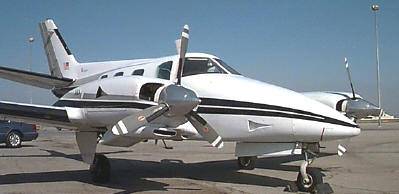Wed, Dec 02, 2009
Flap Rigging Indicated In At Least One Accident
 The FAA has issued a Special Airworthiness Information
Bulletin (SAIB) regarding an airworthiness concern on Hawker
Beechcraft Model 60 (Duke) Series twin-engine powered
airplanes.
The FAA has issued a Special Airworthiness Information
Bulletin (SAIB) regarding an airworthiness concern on Hawker
Beechcraft Model 60 (Duke) Series twin-engine powered
airplanes.
In at least one instance, a Hawker Beechcraft Model 60 (Duke)
airplane impacted terrain after attempting to takeoff, which
resulted in the airplane being destroyed. The flap actuators
recovered at the crash site indicated that the left flap was fully
retracted and the right flap was fully extended, which may have
contributed to the accident. Further examination of the flap
actuators revealed evidence of torsional-induced overload on the
output shaft and corrosion on the output drive shaft subassembly,
key location, and roller bearings.
The roller bearings showed evidence of binding. Proper rigging
is essential to assure the correct operation of the flap system. If
the flap bottoms out in the flap track before the flap limit switch
deactivates the motor, it will stress the actuator, the 90-degree
output shaft, and key. Repeated cycles with this condition may
result in fractures in the key and output shaft.
The internal parts of both actuators were covered with a blend
of oil and bearing grease. While it is normal to have grease and
oil present in the actuator, the mixture of grease and oil on the
actuator screw may be an indication that grease had been used to
lubricate the actuator screw rather than oil. The Beechcraft Duke
Model 60 Series Maintenance Manual (P/N 60-590001- 25) requires the
actuator be lubricated with MIL-L-6086 Grade M oil (gear oil) every
1,000 hours. In addition, it requires that the actuator be replaced
or overhauled every 2,000 hours. The Hawker Beechcraft Duke Model
60 Component Maintenance Manual (P/N 60-590001-27) requires the
bearings to be packed with MIL-G-23827 grease before the actuator
is reassembled.

The FAA recommends that owners, operators, and maintenance
personnel thoroughly review, understand, and adhere to the
information published in the documentation identified above to
maintain the flap system in an airworthy condition. Special
emphasis should be placed on the correct flap system rigging,
actuator overhaul and inspection criteria, and the use of the
proper lubricants.
Failure to do so can have serious consequences.
More News
Klyde Wonders If The 'New' SouthWest Can 'Out-Spirit' Spirit... FMI: www.klydemorris.com>[...]
From 2012 (YouTube Edition): Extensive Expertise in Backup Solutions Makes MCIA Uniquely Qualified In This Market There's no such thing, in aviation, as TOO much caution... hence t>[...]
Aero Linx: Historic Aircraft Association (HAA) The Historic Aircraft Association (HAA) was founded in 1979 with the aim of furthering the safe flying of historic aircraft in the UK>[...]
Jamming Denotes emissions that do not mimic Global Navigation Satellite System (GNSS) signals (e.g., GPS and WAAS), but rather interfere with the civil receiver's ability to acquir>[...]
"Respectfully, U.S. and European airlines should not be even contemplating the future purchase of airplanes from Chinese military companies...” Source: US Representative Raja>[...]
 Klyde Morris (05.02.25)
Klyde Morris (05.02.25) Classic Aero-TV: Introducing The MD302--Mid-Continent's Standby Attitude Module
Classic Aero-TV: Introducing The MD302--Mid-Continent's Standby Attitude Module ANN's Daily Aero-Linx (05.04.25)
ANN's Daily Aero-Linx (05.04.25) ANN's Daily Aero-Term (05.04.25): Jamming
ANN's Daily Aero-Term (05.04.25): Jamming Aero-News: Quote of the Day (05.04.25)
Aero-News: Quote of the Day (05.04.25)




